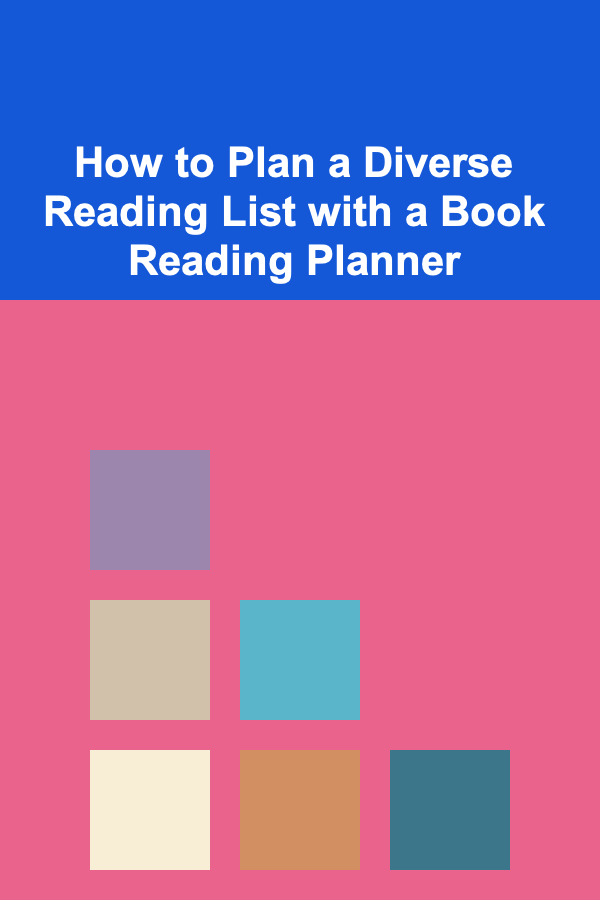
How to Plan a Diverse Reading List with a Book Reading Planner
ebook include PDF & Audio bundle (Micro Guide)
$12.99$6.99
Limited Time Offer! Order within the next:

In a world overflowing with books, creating a reading list that spans genres, authors, and cultural perspectives can be both exciting and daunting. A well-curated reading list not only enriches your intellectual world but also introduces you to new ideas, narratives, and experiences. However, the challenge lies in choosing the right books, organizing them in a way that maximizes learning, and ensuring that your reading journey is diverse and balanced.
This article will guide you through the process of planning a diverse reading list using a book reading planner. By incorporating thoughtful strategies and tools, you'll be able to build a reading list that expands your horizons and offers a multifaceted literary experience.
Why Diversifying Your Reading List Matters
Before delving into the how, it's important to first understand why a diverse reading list is beneficial. A diverse reading list doesn't just mean a variety of genres---it encompasses a broad range of authors, themes, and perspectives. Here are several key reasons why diversifying your reading list is essential:
- Exposure to Different Cultures and Experiences: Reading books from different countries, written by authors of different cultural backgrounds, exposes you to diverse viewpoints and ways of life. This allows you to broaden your understanding of the world, especially in a globalized society.
- Intellectual Growth: When you read works from different genres, such as history, philosophy, science fiction, fantasy, and memoir, you encourage intellectual growth. Each genre has its own conventions, structures, and methods of conveying information, which helps develop critical thinking skills.
- Empathy Development: Reading stories of different people from varied walks of life fosters empathy. Whether it's a novel about a marginalized community, a biography about an influential figure, or a work of fiction from a culture you're unfamiliar with, literature enables you to see the world from different perspectives.
- Escaping Comfort Zones: A diverse reading list pushes you outside your comfort zone and encourages you to read books you might not normally pick up. This can lead to discovering new authors, genres, and topics that resonate with you in unexpected ways.
- Personal Development: A well-rounded reading list can also contribute to your personal growth. Books on self-improvement, leadership, psychology, and personal narratives offer valuable lessons that can be applied in everyday life.
Now that we understand the importance of a diverse reading list, let's look at how you can plan one using a book reading planner.
Step 1: Define Your Reading Goals
Before you dive into picking books for your list, take a moment to define your reading goals. What do you want to achieve with your reading? Are you looking to expand your knowledge in specific areas or simply enjoy a variety of stories? Here are a few questions to ask yourself when setting goals:
- Personal Enrichment: Do you want to expand your understanding of different subjects (history, psychology, sociology, etc.)? Perhaps you're interested in deepening your knowledge of particular topics or exploring new ones.
- Exploration of Different Cultures: Do you want to read books from diverse cultural perspectives? Think about including authors from countries or regions you are less familiar with.
- Genre Exploration: Are you looking to dive deeper into specific genres, like fantasy, science fiction, mystery, or memoirs? A diverse reading list can include books from various genres to keep your reading experience dynamic.
- Author Diversity: Would you like to explore books written by authors of different genders, races, or backgrounds? You might want to intentionally seek out books by authors from underrepresented groups to make your list more inclusive.
- Tackling Length and Difficulty: Are you looking to challenge yourself with longer or more complex books, or do you want a balance of lighter and heavier reads?
Once you've established your goals, you can use them as a guide to select books that align with your interests while also ensuring diversity in your list.
Step 2: Categorize Your Reading Interests
The next step is to categorize your reading interests into different themes, genres, or categories. This helps you get a broad sense of what areas you want to focus on and how diverse your reading list is. Common categories might include:
1. Genres
- Fiction: Novels, short stories, literary fiction, contemporary fiction, historical fiction, fantasy, sci-fi, etc.
- Non-Fiction: Biographies, memoirs, history, self-help, philosophy, science, social issues, etc.
- Poetry: Exploring poetry collections or individual poets from different traditions.
- Drama: Plays and screenplays that highlight different styles and cultures.
2. Author Representation
- International Authors: Books written by authors from different countries and continents.
- Underrepresented Groups: Authors who are part of marginalized communities (e.g., LGBTQ+, racial minorities, women authors).
- Classics vs. Contemporary: A balance between classic works and contemporary literature can provide both historical context and current perspectives.
3. Themes
- Cultural Exploration: Books that focus on cultural identity, migration, history, and global issues.
- Social Justice: Works that explore issues of race, gender equality, poverty, and activism.
- Personal Growth and Development: Self-improvement books, psychology, motivational works, etc.
- Philosophy and Ethics: Books that delve into fundamental questions of life, morality, and existence.
Categorizing your interests helps you visualize where you might have gaps in your reading. Are you reading too many books in one genre and neglecting others? Are there certain types of authors or themes that are underrepresented in your list? A planner will help you assess this.
Step 3: Create a Reading Planner Template
A reading planner is an essential tool in organizing your diverse reading list. There are different ways to approach creating your planner, and you can use either a physical planner or a digital tool. Here's how to set up your planner:
1. List Your Categories
At the top of your reading planner, create sections for each of the categories you've defined. This will give you an overview of the different themes and genres you want to explore. You can have sections like:
- Fiction
- Non-fiction
- Poetry
- History
- Author Diversity
- International Literature
2. Set Monthly or Weekly Targets
Based on your reading goals, determine how much time you want to dedicate to reading each week or month. For example:
- Monthly Target: Aim to read 4-6 books each month, selecting at least one book from each category.
- Weekly Target: Aim to read 100 pages a week, adjusting depending on the length of the book.
3. Create a Book List for Each Category
Under each category, list books that interest you. Be sure to include a balance of authors, genres, and themes. Don't hesitate to include books that challenge your thinking or push you outside of your usual preferences. For example:
- Fiction : The Night Circus by Erin Morgenstern (Fantasy), The Goldfinch by Donna Tartt (Literary Fiction)
- Non-fiction : Sapiens by Yuval Noah Harari (History), Becoming by Michelle Obama (Memoir)
- Poetry : Milk and Honey by Rupi Kaur, The Waste Land by T.S. Eliot
- International Authors : One Hundred Years of Solitude by Gabriel García Márquez (Colombian), The Kite Runner by Khaled Hosseini (Afghan-American)
4. Track Your Progress
Set up a system to track your reading progress. Use columns like:
- Title: The book's name.
- Category: The category it falls under (Fiction, Non-fiction, etc.).
- Start Date: When you began the book.
- End Date: When you finished it.
- Rating/Review: A personal rating (1-5 stars) or a short review to reflect on what you learned or enjoyed.
You can also leave space to jot down specific lessons or thoughts you had during your reading.
Step 4: Evaluate and Adjust
After a few months of using your reading planner, take some time to evaluate how well your reading list reflects your goals. Ask yourself:
- Have I met my diversity goals? Did I read from a broad range of authors, genres, and cultures?
- Am I pushing myself to read challenging books?
- Am I engaging with diverse perspectives and ideas?
- Do I feel inspired and motivated to continue reading?
If you find that certain areas are underrepresented or you're gravitating toward only a handful of genres, it might be time to adjust your reading plan. Add new books to your list, explore new authors, and keep pushing yourself to expand your literary world.
Conclusion
A well-planned, diverse reading list offers a window into the world beyond your immediate experiences. It challenges you to think critically, encourages empathy, and fosters lifelong learning. By using a book reading planner, you can organize your goals, track your progress, and ensure that your reading list remains varied, engaging, and enriching.
So grab a planner---digital or physical---and start mapping out your literary journey. With intention and curiosity, you'll build a collection of books that not only entertains but also educates, empowers, and inspires you for years to come.
Reading More From Our Other Websites
- [Home Space Saving 101] How to Declutter Your Bathroom with Ingenious Vertical Storage Ideas
- [Organization Tip 101] How to Use Financial Goals to Motivate Your Budgeting
- [Organization Tip 101] How to Incorporate Seasonal Recipes into Your Collection
- [Home Pet Care 101] How to Brush a Pet's Teeth: A Step-by-Step Guide for Pet Owners
- [Personal Financial Planning 101] How to Use Financial Apps to Track Your Progress and Goals
- [Organization Tip 101] Transform Your Small Bathroom with These Stylish Design Ideas
- [Home Budget 101] How to Create a Budget for Beginners: Your Step-by-Step Guide to Financial Control
- [Personal Investment 101] How to Make Money by Licensing Your Deep Learning Algorithms
- [Home Pet Care 101] How to Choose the Right Pet Carrier for Your Travel Needs
- [Skydiving Tip 101] Beyond the Jump: How Skydiving Lessons Build Confidence and Skills for Everyday Life

How to Get Your Transportation Business Legally Registered: An Actionable Guide
Read More
How to Save on Landscaping and Lawn Care Costs
Read More
How to Use Gamification for Productivity
Read More
How to Experience the Cherry Blossoms in Washington State
Read More
How to Design Infographics for Social Impact
Read More
How to Use an Internship Application Checklist to Stay Organized
Read MoreOther Products

How to Get Your Transportation Business Legally Registered: An Actionable Guide
Read More
How to Save on Landscaping and Lawn Care Costs
Read More
How to Use Gamification for Productivity
Read More
How to Experience the Cherry Blossoms in Washington State
Read More
How to Design Infographics for Social Impact
Read More